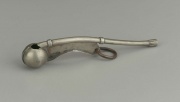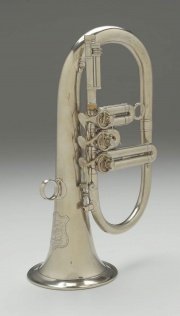Difference between revisions of "Nickel silver"
(username removed) |
(username removed) |
||
| Line 17: | Line 17: | ||
== Additional Information == | == Additional Information == | ||
| − | Adrienne Cowden, "Nickel Silver", in ''Twentieth-Century Building Materials'', T. Jester (ed.), McGraw-Hill: New York, 1995. | + | ° Adrienne Cowden, "Nickel Silver", in ''Twentieth-Century Building Materials'', T. Jester (ed.), McGraw-Hill: New York, 1995. ° F.B. Howard-White, ''Nickel: An Historical Review'' New York: D. Van Nostrand Company, 1963. ° R.Child,"The Identification of Post-Industrial Revolution Metals" in ''Modern Metals in Museums'', Institute for Archaeology Publications, London, 1988. |
== Authority == | == Authority == | ||
| − | * | + | * Thomas Gregory, ''The Condensed Chemical Dictionary'', Reinhold Publishing, New York, 3rd ed., 1942 |
| − | * | + | * G.S.Brady, ''Materials Handbook'', McGraw-Hill Book Co., New York, 1971 Comment: p. 542 |
| − | * | + | * David C. Scott, ''Metallography and Microstructure of Ancient and Historic Metals'', The Getty Conservation Institute, Los Angeles, 1991 |
* ''Dictionary of Building Preservation'', Ward Bucher, ed., John Wiley & Sons, Inc., New York City, 1996 | * ''Dictionary of Building Preservation'', Ward Bucher, ed., John Wiley & Sons, Inc., New York City, 1996 | ||
| − | * | + | * Thomas C. Jester (ed.), ''Twentieth-Century Building Materials'', McGraw-Hill Companies, Washington DC, 1995 Comment: Adrienne Cowden, "Nickel Silver" |
| − | * | + | * Zora Sweet Pinney, 'A Handle on the Terms used for Artists' Brushes', unpublished glossary, 1999 |
| − | * | + | * Tom Rowland, Noel Riley, ''A-Z Guide to Cleaning, Conserving and Repairing Antiques'', Constable and Co., Ltd., London, 1981 |
| − | * | + | * External source or communication Comment: Contribution by Arian Sheets |
* Wikipedia, the free encyclopedia, at http://www.wikipedia.com Comment: German silver: 45-70% copper, 5-30% nickel, 8-45% zinc; originated in China, produced by Suhl in Germany in 1770. | * Wikipedia, the free encyclopedia, at http://www.wikipedia.com Comment: German silver: 45-70% copper, 5-30% nickel, 8-45% zinc; originated in China, produced by Suhl in Germany in 1770. | ||
Revision as of 06:29, 24 July 2013
Description
A silvery white alloy composed of copper (52-80%), zinc (10-35%), and nickel (5-35%). Originally produced in China, nickel silver was first manufactured in Germany in 1770; the process was later perfected in 1823. It was used as an inexpensive, non-tarnishing substitute for silver. Nickel silver can take a high polish and became popular during the 19th century for tableware and plated articles. It was also favored for use in ferrules of expensive artist brushes. Because it provides a harder, stronger, and more durable base than copper, nickel silver is still used as a base for silver-plated items (marked EPNS-electroplated nickel silver). Nickel silver is ductile and nonmagnetic. It can be wrought, cast, rolled, stamped, extruded, and machined. The addition of small amount of lead allows nickel silver to be soldered and welded. Beginning in the 1920s nickel-silver became popular for interior and exterior architectural motifs such as decorative panels, stair railings, elevator doors, plumbing fixtures, hardware, and decorative strips in terrazzo floor designs. By the 1950s, it was rarely used as an architectural element.
Synonyms and Related Terms
German silver; Neusilber (Deut.); Argentan (Deut.); maillechort (Fr.); albata; Paktong; Pakfong; Alpacca [Berndorf AG]; neusilver; white copper; Liberty silver; Nevada silver; Queen's metal; white metal; Wolfram brass; Argentine; Packtong; Silveroid; electrum; Best best; Virginia silver; Potosi silver
Other Properties
Resistant to atmospheric corrosion and acids. Outdoor samples develop a thin brownish green protective patina that is often confused with Monel.
Will tarnish in the presence of sulfur.
Additional Information
° Adrienne Cowden, "Nickel Silver", in Twentieth-Century Building Materials, T. Jester (ed.), McGraw-Hill: New York, 1995. ° F.B. Howard-White, Nickel: An Historical Review New York: D. Van Nostrand Company, 1963. ° R.Child,"The Identification of Post-Industrial Revolution Metals" in Modern Metals in Museums, Institute for Archaeology Publications, London, 1988.
Authority
- Thomas Gregory, The Condensed Chemical Dictionary, Reinhold Publishing, New York, 3rd ed., 1942
- G.S.Brady, Materials Handbook, McGraw-Hill Book Co., New York, 1971 Comment: p. 542
- David C. Scott, Metallography and Microstructure of Ancient and Historic Metals, The Getty Conservation Institute, Los Angeles, 1991
- Dictionary of Building Preservation, Ward Bucher, ed., John Wiley & Sons, Inc., New York City, 1996
- Thomas C. Jester (ed.), Twentieth-Century Building Materials, McGraw-Hill Companies, Washington DC, 1995 Comment: Adrienne Cowden, "Nickel Silver"
- Zora Sweet Pinney, 'A Handle on the Terms used for Artists' Brushes', unpublished glossary, 1999
- Tom Rowland, Noel Riley, A-Z Guide to Cleaning, Conserving and Repairing Antiques, Constable and Co., Ltd., London, 1981
- External source or communication Comment: Contribution by Arian Sheets
- Wikipedia, the free encyclopedia, at http://www.wikipedia.com Comment: German silver: 45-70% copper, 5-30% nickel, 8-45% zinc; originated in China, produced by Suhl in Germany in 1770.

